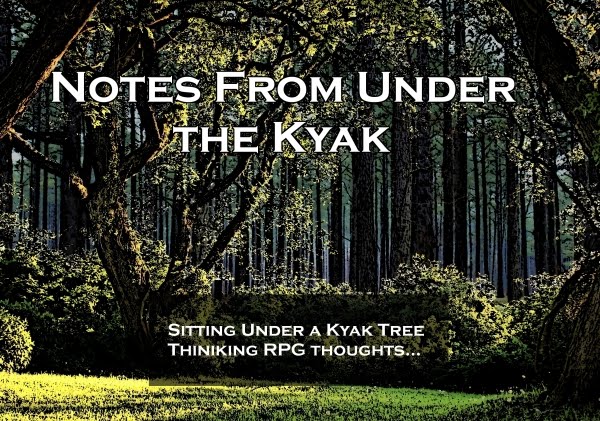Thursday, April 7, 2011
Because It's What I Like
Monday, April 4, 2011
Grey Watchers
TYPE: Supernatural (Undead)
FREQUENCY: Very rare
NO. APPEARING: 1-10
ARMOR CLASS: 4
MOVE: 9”
HIT DICE: 4
% IN LAIR: 100%
TREASURE TYPE: Nil (see below)
NO. OF ATACKS: 1 claw (as F1)
DAMAGE/ATTACK: see below
SPECIAL ATTACKS:
See description
SPECIAL DEFENSES: non-corporeal only hit by +1 or better weapons
MAGIC RESISTANCE: 20%
INTELLIGENCE: Average
ALIGNMENT Neutral
SIZE: M
LEVEL/X.P. VALUE:IV/240+4/hp
Non-corporeal, non-evil undead which have been created to accomplish specific tasks. Once the specific task is accomplished, the Grey Watchers melt into oblivion. The task can be as specific or general as the creator desires, though the Grey Watcher will only exist as long as the corporeal body is still intact (see below). For example, Grey Watchers have been set to watch for the return of the great king and announce his arrival (however, since he never returned, they have been posted for 700 years waiting). Grey Watchers are often set to act as guides or guardians for specific areas (with no end given – “guide all who enter this room to wherever they desire to go within the complex” “if anyone without the mark of the Griffon enters the room, set the traps”). Grey Watchers are very limited in the scope of their instructions (given at the most two or three general instructions), as well as the range within which they can work (limited to about a 1200 foot radius).
While Grey Watchers have no physical presence (non-corporeal) and can only be hit by +1 or better weapons,they can affect the physical world by expending their own hit points. That is, each hit point they expend gives them one point of strength, for example, or causes one point of damage if the Watcher is able to hit a target. Watchers will expend a single hit point to accomplish relatively simple tasks such as closing a door, moving a lever, pushing an object, even tapping a physical being on the shoulder. More difficult tasks require more hit points expended (moving a heavy object would be adjudicated according to the strength table – so it might require multiple Watchers to move a very heavy object). Grey Watchers regenerate hit points at a rate of one per round, even if reduced to zero (though reducing a Grey Watcher to zero hit points will cause it to return to its bodily remains and regenerate to its full hit points there, at a much slower rate - 1 hit point per day).
Grey Watchers can only be truly destroyed by destroying their physical remains completely (incineration, wish, sending the remains to another plane, etc).
In combat, Grey Watchers will attempt to hit with what amounts to a claw attack. They attack as a first level Fighter. Hit points are expended in the attempt, thus even if the attack doesn’t hit, the Grey Watcher loses the hit points. Only in extreme circumstances will a Grey Watcher attack with enough hit points to reduce itself to zero (in defense of its physical remains, for example). So, a Grey Watcher with 19 hit points attacks an intruder, attempting to hit with 14 points. The attack misses, so the Grey Watcher is reduced to 5 hit points. It might attempt to strike again the following round, though it would probably only attack with 3 or 4 hit points. Reduced to one or two hit points, Grey Watchers will typically attempt to flee and regenerate their hit points before re-engaging with an enemy. Grey Watchers will not willingly return to their corpses, hating the reminder of their cursed existence. They typically try to avoid combat and they will go to great lengths to preserve at least a few hit points.
While Grey Watchers themselves have no treasure, treasures may have been buried with their physical bodies.
Saturday, April 2, 2011
The Awesomeness of DL1 - Dragons of Despair
10. Sentinel Gap Walls of granite soar on either side of the narrow canyon floor. A chilly breeze whistles and tumbles between the cliffs.
and some of the areas have more detail. The above is enough for me to get a sense of the place as the PCs visit it.
I actually liked that there were ways to get the PCs to one of the Expositors of Plot (the Pegasi will take them to the Forestmaster no matter what they want if they capture them and fly them, the Centaurs will carry them there) because the PCs would be free to NOT capture the Pegasi and, of course, they don't HAVE to go into the forest at all if they choose not to. There just enough detail in the "throwaway areas" that I could probably build adventures in every one of those locales (and might have to, since this is a true old school product with Random Encounter tables). I'm looking at DL1 as my model for hex filling - for rounding out a wilderness area with general descriptions and letting random tables to their thing for the details.
Yes, the plot following got way too heavy handed (really, if a NPC gets killed and he is needed later...you really use the soap opera convention on him? Really?) and the need to follow these particular characters was annoying... But it started off so promising.
So, don't buy any of the rest of the line. But DL1 is, for me, a nearly perfect AD&D adventure.***
***yeah, okay, except the freaking typos and the terrible editing job...but CONTENT...it's one of the best.







































.jpg)




































.jpg)





























.png)













.jpg)





























































































































.JPG)





















